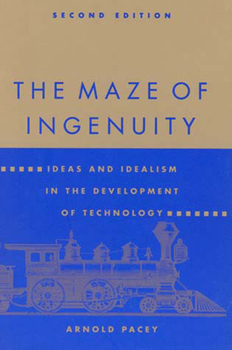The Maze of Ingenuity, second edition: Ideas and Idealism in the Development of Technology
Select Format
Select Condition 
Book Overview
From cathedrals to star wars, Arnold Pacey looks at the interaction of technologies and society over the last thousand years and uses that survey to argue for a more humane form of future... This description may be from another edition of this product.
Format:Paperback
Language:English
ISBN:026266075X
ISBN13:9780262660754
Release Date:January 1992
Publisher:MIT Press
Length:318 Pages
Weight:1.15 lbs.
Dimensions:0.7" x 6.0" x 8.9"
Age Range:18 years and up
Grade Range:Postsecondary and higher
Customer Reviews
2 ratings
How should technology be applied?
Published by Thriftbooks.com User , 17 years ago
"The maze is technology in Europe from 1100 through 1870. It is divided into periods which seem to reflect the changes in ideas and outlook toward technological innovation. People, Pacey argues, were motivated by humanitarian, social, and intellectual ideals, or a need to master nature. Historical examples demonstrate how technological progress led in many directions. But now we must "think carefully about the ideals and objectives [so] as to chose the right direction in which we want to go."(17) The idealism of prior ages is fading, Pacey says, "because of the inhumanity of some of its [technological] applications - and because of the ecological effects of its polluting and destructive misuse."(308) In developing his theme he hopes to shed light on current dilemmas and how technology should be applied. Favored by geography, European technology wove a pattern of progress trending between social and economic objectives which encouraged exploitive devices to harness natural forces and advance technological utility. The eleventh century is critical because it was then that Europeans combined eastern ideas to its indigenous ability and inaugurated an era of technical innovation. This developed a conscious process of innovation. As an example, Pacey points to the Cathedral at Durham where the architecture demonstrates use of the rib vault, pointed arch, and the flying buttress. Ideas, such as Roger Bacon's, elevated the importance of manual labor and technical prowess. Hard work along with pious mental obligations, encouraged monks to think of better ways of doing things. Over time Monasteries became more than self sufficient and marketed their excess production which stimulated urban trade. Economic and spiritual objectives served to encouraged technical progress. Even the lowliest peasant was probably not unaware of the benefits of machines. According to the "Domesday Book" in 1086 there were probably as many as 6000 water-mills in England. Machines set men free and work was to be respected. All this contributed to a process of innovation. With the advent of the clock, time became a part of people's consciousness regulating life and production. Time was precious and labor could not be wasted. Improved water and wind mills, and, later, steam power permitted an increased standard of living. The main point that I come away with after reading "The Maze of Ingenuity" is that there are varied motives for technological advancement - Pacey speaks of it as the maze. It may be social, symbolic, intellectual, or economic, but more often than not, nontechnical motives direct the advancement of technology. For example, it was not economical to build large Cathedrals, but in doing so machines were developed which assisted in construction and made men more productive. Pacey feels that in the past moral objectives seem to have out weighed utilitarian ones, whereas the opposite exists today. Pacey does not offer any advice on what to do about that promp
Definitely worthwhile.
Published by Thriftbooks.com User , 20 years ago
This book is the story of technological development in the West from the Middle Ages until 1920. It is organized around two related questions: what in civilization contributed to progress, and what were the objectives. Pacey obviously knows the history of technology very well, and for the most part lets the details be his guide. While there are broader themes, local interests often play a big role. At the same time, Pacey does not let the trees obscure the forest. My problem with the book is that I am somewhat mechanically challenged, and simply did not understand many of Pacey's diagrams and explanations. I would love to understand how the design of cathedrals in the Middle Ages was done differently than in the more modern use of architectural drawings, but I couldn't follow. Never-the-less, I got enough out of the book to find it quite interesting. I did understand the discussion of Galileo's work with levers and where it took him, and found it fascinating. Did you know he was one of the first people in history to grapple with the problem of why scaling up mechanical models often didn't work?





